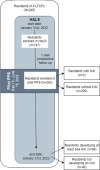Validation of the prevalence to incidence conversion method for healthcare associated infections in long-term care facilities
- PMID: 38512824
- PMCID: PMC10956812
- DOI: 10.1371/journal.pone.0300794
Validation of the prevalence to incidence conversion method for healthcare associated infections in long-term care facilities
Abstract
Introduction: Residents of long-term care facilities (LTCFs) are a population at high risk of developing severe healthcare associated infections (HAIs). In the assessment of HAIs in acute-care hospitals, selection bias can occur due to cases being over-represented: patients developing HAIs usually have longer lengths of stays compared to controls, and therefore have an increased probability of being sampled in PPS, leading to an overestimation of HAI prevalence. Our hypothesis was that in LTCFs, the opposite may occur: residents developing HAIs either may have a greater chance of being transferred to acute-care facilities or of dying, and therefore could be under-represented in PPS, leading to an underestimation of HAI prevalence. Our aim was to test this hypothesis by comparing HAI rates obtained through longitudinal and cross-sectional studies.
Methods: Results from two studies conducted simultaneously in four LTCFs in Italy were compared: a longitudinal study promoted by the European Centre for Disease Prevention and Control (ECDC, HALT4 longitudinal study, H4LS), and a PPS. Prevalence was estimated from the PPS and converted into incidence per year using an adapted version of the Rhame and Sudderth formula proposed by the ECDC. Differences between incidence rates calculated from the PPS results and obtained from H4LS were investigated using the Byar method for rate ratio (RR).
Results: On the day of the PPS, HAI prevalence was 1.47% (95% confidence interval, CI 0.38-3.97), whereas the H4LS incidence rate was 3.53 per 1000 patient-days (PDs, 95% CI 2.99-4.08). Conversion of prevalence rates obtained through the PPS into incidence using the ECDC formula resulted in a rate of 0.86 per 1000 PDs (95% CI 0-2.68). Comparing the two rates, a RR of 0.24 (95% CI 0.03-2.03, p 0.1649) was found.
Conclusions: This study did not find significant differences between HAI incidence estimates obtained from a longitudinal study and through conversion from PPS data. Results of this study support the validity of the ECDC method.
Copyright: © 2024 Vicentini et al. This is an open access article distributed under the terms of the Creative Commons Attribution License, which permits unrestricted use, distribution, and reproduction in any medium, provided the original author and source are credited.
Conflict of interest statement
The authors have declared that no competing interests exist.
Figures


References
-
- Furmenti MF, Rossello P, Bianco S, Olivero E, Thomas R, Emelurumonye IN, et al.. Healthcare-associated infections and antimicrobial use in long-term care facilities (HALT3): an overview of the Italian situation. Journal of Hospital Infection. 2019;102(4):425–430. doi: 10.1016/j.jhin.2019.02.007 - DOI - PubMed
-
- Ricchizzi E, Latour K, Kärki T, Buttazzi R, Jans B, Moro ML, et al.. Antimicrobial use in european long-term care facilities: Results from the third point prevalence survey of healthcare-associated infections and antimicrobial use, 2016 to 2017. Eurosurveillance. 2018;23(46). doi: 10.2807/1560-7917.ES.2018.23.46.1800394 - DOI - PMC - PubMed
-
- Rossow J, Ostrowsky B, Adams E, Greenko J, McDonald R, Vallabhaneni S, et al.. Factors Associated with Candida auris Colonization and Transmission in Skilled Nursing Facilities with Ventilator Units, New York, 2016–2018. Clinical Infectious Diseases. 2021;72(11):E753–E760. doi: 10.1093/cid/ciaa1462 - DOI - PMC - PubMed
-
- Vicentini C, Quattrocolo F, D’Ambrosio A, Corcione S, Ricchizzi E, Moro ML, et al.. Point prevalence data on antimicrobial usage in Italian acute-care hospitals: Evaluation and comparison of results from two national surveys (2011–2016). Infect Control Hosp Epidemiol. 2020;41(5):579–584. doi: 10.1017/ice.2020.18 - DOI - PubMed
-
- Suetens C, Latour K, Kärki T, Ricchizzi E, Kinross P, Moro ML, et al.. Prevalence of healthcare-associated infections, estimated incidence and composite antimicrobial resistance index in acute care hospitals and long-term care facilities: Results from two european point prevalence surveys, 2016 to 2017. Eurosurveillance. 2018;23(46). doi: 10.2807/1560-7917.ES.2018.23.46.1800516 - DOI - PMC - PubMed
MeSH terms
LinkOut - more resources
Full Text Sources
Miscellaneous

